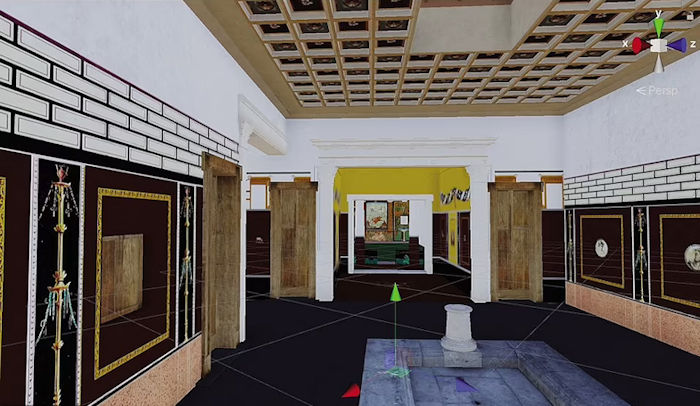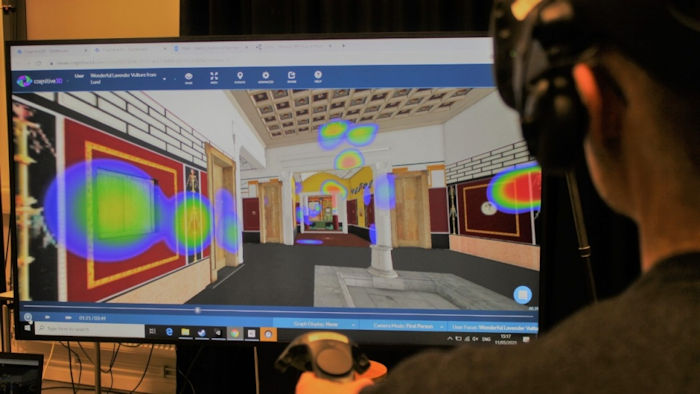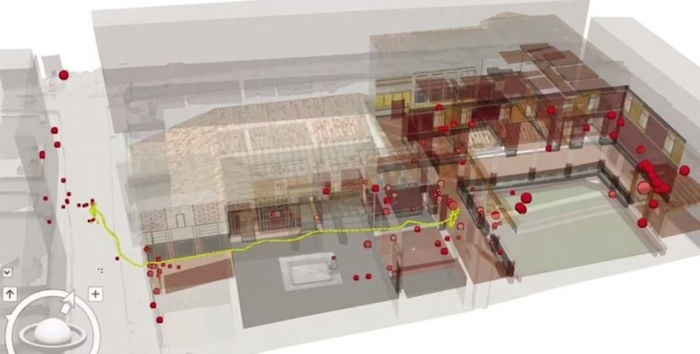Conny Waters – AncientPages.com – Before the devastating eruption of Mount Vesuvius in 79 A.D, people in Pompeii lived a comfortable life.
At the time of the destruction, Pompeii was a flourishing ancient city with magnificent houses, streets, and shops, but everything would remain lost, forgotten, sealed, and preserved in a time capsule for more than seventeen centuries.

The researchers have created 3D models of the House of Greek Epigrams, which can be explored in virtual reality. Credit: Lund University
Over the years archaeologists have unearthed skeletons and ancient ruins that give a better understanding of daily life in the lost city of Pompeii.
Now with help of virtual reality scientists have re-constructed an ancient home in Pompeii, complete with restored paintings and stunning frescoes and we can glimpse inside and see what it looked like before it was destroyed 1,900 years ago.
“Work and daily activities were intermingled during the day. The house communicated to people about the personal power and status of the owner and his family,” said Danilo Marco Campanaro, a Ph.D. candidate from Lund University and co-author of the research.
Using virtual reality-based eye-tracking techniques and 3D Geographical Information Systems, researchers from the department of archeology and ancient history at Lund University in Sweden re-constructed the House of the Greek Epigrams, a home in northeast Pompeii.
According to the study published in the journal Antiquity, historical records suggest that Roman homes were designed to emphasize certain features while hiding others.
However, this is not the first time that scientists have found evidence of architectural tricks employed by Romans.
Previous studies have revealed how some Roman architects used angled walls and raised floors to make the interior of homes appear bigger from the front door.

The Roman house in VR, with eye-catching areas highlighted. Credit: Danilo Marco Campanaro and Giacomo Landeschi, Lund University via Antiquity
“Consequently, scholars have studied such sources in the context of the material remains of Pompeii and Herculaneum. The results suggest that optical axiality played a key role in the apperception of the Roman house and its socio-political significance. ultimately envisaging a type of “vision mania”. Questions such as which spaces within Roman houses were visible to visitors and how house design and visual space contributed to the social atmosphere, however, are still far from being fully answered, the researchers write in their study.
“Previous research has found some used angled walls and raised floors to make the interior of their homes appear bigger to those looking through the front door. The House of the Epigrams, the researchers say, also was once decorated with fresco paintings.
Due to damage caused to Roman houses, the result of centuries of neglect, weathering and volcanoes, the researchers say studying these nuances has proved challenging.

Credit: Danilo Marco Campanaro and Giacomo Landeschi, Lund University via Antiquity
But using virtual reality, the scientists were able to track and measure the visual attention of volunteers as they toured the house,” the CTV News reports.
“Eye-tracking technology and virtual reality do now provide unprecedented opportunities to ᴀssess the visual qualities of ancient spaces,” said Dr. Giacomo Landeschi, co-author of the study.
“The results of this study show how the owner of the house stimulated the visitor’s senses to convey a message about its power and wealth,” Campanaro said.
The researchers hope the findings will help to shed light on why Romans designed their houses the way they did.
“This research has shown that it is possible to collect, quantify and analyze data concerning the visual experience within a virtually reconstructed Pompeian house,’ the researchers said.
“Findings from this newly developed work pipeline may greatly benefit future studies on views and viewing in the Roman house, and the socio-political conditioning of senses as a mode of display for status and power in the ancient domestic realm.
Furthermore, it may, optimistically, reach beyond the boundary of the specific area of interest to involve all archaeological contexts in which visual properties and people intertwine, or in which visual properties are manipulated to prompt behavior,” the researchers explained in their study.
Written by Conny Waters – AncientPages.com Staff Writer





